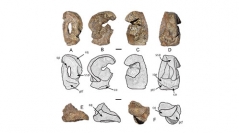

 Comptes Rendus Palevol
14 (6-7) - Pages 483-493
Comptes Rendus Palevol
14 (6-7) - Pages 483-493Halisaurinae is a subfamily of enigmatic, small- to medium-sized mosasauroids, which retain a mosaic of primitive and derived features. The first record of a South American Halisaurus with precise stratigraphic information includes a quadrate carrying a tympanic disc together with twelve vertebrae, collected in the Late Maastrichtian of Jagüel Formation in northern Patagonia (Argentina). The preservation of a tympanic disc allows exploring and discussing the mechanisms of sound transmission in these mosasauroids. The location of the tympanic disc resembles that one formed by the extracolumella of aquatic turtles and at least one extant lizard. Based on morphological comparison of the middle ear we discuss previous hypotheses on the modification of the tympanic middle ear system of mosasauroids for underwater hearing, in a manner similar to that observed in aquatic turtles.
Halisaurus, Patagonia, Late Maastrichtian, Cretaceous, Tympanic disc, Mosasauroidea